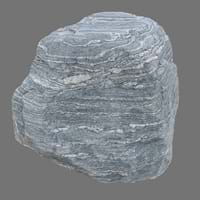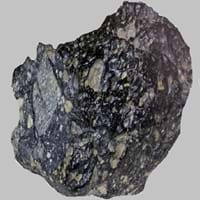Definition
Migmatite is typically a granitic rock within a metamorphic host rock which is composed of two intermingled but distinguishable components
Granite is a very hard, granular, crystalline igneous rock which consists mainly of quartz, mica, and feldspar and is often used as building stone
Origin
Southern Alps, France
Unknown
Discoverer
Jakob Sederholm
Unknown
Etymology
From the Greek word migma which means a mixture
From Italian granito, which means grained rock, from grano grain, and from Latin granum
Class
Metamorphic Rocks
Igneous Rocks
Sub-Class
Durable Rock, Medium Hardness Rock
Durable Rock, Hard Rock
Group
Not Applicable
Plutonic
Other Categories
Coarse Grained Rock, Fine Grained Rock, Medium Grained Rock, Opaque Rock
Coarse Grained Rock, Opaque Rock
Texture
Foliated
Granular, Phaneritic
Color
Black, Bluish - Grey, Brown, Brown- Black, Dark Greenish - Grey, Dark Grey to Black
Black, Grey, Orange, Pink, White
Durability
Durable
Durable
Scratch Resistant
Yes
Yes
Appearance
Dull, Banded and Foilated
Veined or Pebbled
Interior Uses
Countertops, Flooring, Kitchens
Countertops, Decorative Aggregates, Entryways, Floor Tiles, Flooring, Homes, Hotels, Interior Decoration, Kitchens, Stair Treads
Exterior Uses
As Building Stone, As Facing Stone
As Building Stone, As Facing Stone, Bridges, Paving Stone, Garden Decoration, Near Swimming Pools, Office Buildings, Resorts
Other Architectural Uses
Curbing
Curbing
Construction Industry
As Dimension Stone, Cement Manufacture, for Road Aggregate, Making natural cement
As Dimension Stone
Medical Industry
Not Yet Used
Not Yet Used
Antiquity Uses
Artifacts
Monuments, Sculpture, Small Figurines
Commercial Uses
Cemetery Markers, Jewelry, Tombstones, Used to manufracture paperweights and bookends
Curling, Gemstone, Laboratory bench tops, Tombstones, Used in aquariums
Types
Diatexites and Metatexites
Igneous Protolith Granite, Sedimentary Protolith Granite, Mantle Granite, Anorogenic Granite, Hybrid Granite, Granodiorite and Alkali Feldspar Granite
Features
Generally rough to touch, Is one of the oldest rock
Available in Lots of Colors and Patterns, It is One of the Oldest, Strongest and Hardest Rock
Archaeological Significance
Monuments
Not Yet Used
Used
Famous Monuments
Not Applicable
Agia Sophia in Istanbul, Turkey, Blue Domed Church in Santorini, Greece, Blue Mosque in Istanbul, Charminar in Hyderabad, India, Diana, Princess of Wales Memorial Fountain in London, UK, Ephesus in Turkey, Georgia Guidestones in Georgia, US, Hermitage in Saint Petersburg, Khajuraho Temples, India, Mahabalipuram in Tamil Nadu, India, Mysore Palace in Karnataka, India, Signers Monument in Augusta, Georgia, Statue of Liberty in New York, USA, Taj Mahal in Agra, India, Tower Bridge in London, Vietnam Veterans Memorial in Washington, US, Washington Monument, US
Sculpture
Not Yet Used
Used
Famous Sculptures
Not Applicable
Avukana Buddha Statue in Sri Lanka, Lincoln Memorial in America, Mount Rushmore National Memorial in South Dakota, US, The Colossal Red Granite Statue of Amenhotep III in Karnak, Egypt
Pictographs
Used
Not Used
Petroglyphs
Used
Not Used
Figurines
Not Yet Used
Used
Formation
Migmatites form by high temperature regional and thermal metamorphism of protolith rocks where rocks melt partially due to high temperature.
Granite is an intrusive igneous rock which is very hard, crystalline and is visibly homogeneous in texture and forms by melting of continental rocks
Mineral Content
Biotite, Chlorite, Feldspar, Garnet, Graphite, Hornblade, Micas, Muscovite or Illite, Quartz, Quartzite, Silica, Zircon
Amphibole, Biotite, Feldspar, Hornblade, Micas, Muscovite or Illite, Plagioclase, Pyroxene, Quartz
Compound Content
Aluminium Oxide, NaCl, CaO, Carbon Dioxide, Iron(III) Oxide, FeO, Potassium Oxide, Magnesium Carbonate, MgO, MnO, Phosphorus Pentoxide, Silicon Dioxide, Titanium Dioxide
Aluminium Oxide, CaO, Iron(III) Oxide, FeO, Potassium Oxide, MgO, MnO, Sodium Oxide, Phosphorus Pentoxide, Silicon Dioxide, Titanium Dioxide
Types of Metamorphism
Burial Metamorphism, Cataclastic Metamorphism, Regional Metamorphism
Burial Metamorphism, Cataclastic Metamorphism
Types of Weathering
Biological Weathering, Chemical Weathering, Mechanical Weathering
Biological Weathering
Types of Erosion
Chemical Erosion, Glacier Erosion, Water Erosion, Wind Erosion
Chemical Erosion, Sea Erosion, Water Erosion
Grain Size
Medium to Fine Coarse Grained
Large and Coarse Grained
Fracture
Irregular
Not Available
Porosity
Very Less Porous
Less Porous
Luster
Dull to Pearly to Subvitreous
Dull to Grainy with Sporadic parts Pearly and Vitreous
Compressive Strength
Not Available
Cleavage
Poor
Not Available
Toughness
1.2
Not Available
Specific Gravity
2.65-2.75
2.6-2.7
Transparency
Opaque
Opaque
Density
Not Available
2.65-2.75 g/cm3
Specific Heat Capacity
Not Available
Resistance
Heat Resistant, Pressure Resistant
Heat Resistant, Wear Resistant
Deposits in Eastern Continents
Asia
China, India, Iran, Iraq, Kazakhstan, Kyrgyzstan, Mongolia, Russia
China, India, Iran, Saudi Arabia, Sri Lanka, Taiwan, Thailand, Turkey, Vietnam
Africa
Cameroon, Ethiopia, Ghana, Kenya, Madagascar, Morocco, Mozambique, Namibia, Nigeria, Tanzania, Togo
Angola, Egypt, Madagascar, Namibia, Nigeria, South Africa
Europe
Albania, Austria, Bosnia and Herzegovina, Finland, France, Georgia, Germany, Hungary, Italy, Kosovo, Monaco, Norway, Poland, Romania, Serbia, Slovakia, Slovenia, Sweden, Switzerland, Ukraine, United Kingdom
Austria, Belgium, Finland, France, Germany, Italy, Norway, Sardinia, Spain, Switzerland, The Czech Republic, Venezuela
Others
Not Yet Found
Not Yet Found
Deposits in Western Continents
North America
Canada, Costa Rica, Cuba, Mexico, Panama, USA
Canada, USA
South America
Argentina, Bolivia, Brazil, Chile, Colombia, Ecuador, Peru, Venezuela
Not Yet Found
Deposits in Oceania Continent
Australia
New South Wales, New Zealand, Queensland, Victoria
Not Yet Found
Migmatite vs Granite Characteristics
Though some rocks look identical, they have certain characteristics which distinguish them from others. Characteristics of rocks include texture, appearance, color, fracture, streak, hardness etc. Migmatite vs Granite characteristics assist us to distinguish and recognize rocks. Also you can check about Properties of Migmatite and Properties of Granite. Learn more about Migmatite vs Granite in the next section. The interior uses of Migmatite include Countertops, Flooring and Kitchens whereas the interior uses of Granite include Countertops, Decorative aggregates, Entryways, Floor tiles, Flooring, Homes, Hotels, Interior decoration, Kitchens and Stair treads. Due to some exceptional properties of Migmatite and Granite, they have various applications in construction industry. The uses of Migmatite in construction industry include As dimension stone, Cement manufacture, For road aggregate, Making natural cement and that of Granite include As dimension stone.
More about Migmatite and Granite
Here you can know more about Migmatite and Granite. The life cycle of a rock consists of formation of rock, composition of rock and transformation of rock. The composition of Migmatite and Granite consists of mineral content and compound content. The mineral content of Migmatite includes Biotite, Chlorite, Feldspar, Garnet, Graphite, Hornblade, Micas, Muscovite or Illite, Quartz, Quartzite, Silica, Zircon and mineral content of Granite includes Amphibole, Biotite, Feldspar, Hornblade, Micas, Muscovite or Illite, Plagioclase, Pyroxene, Quartz. You can also check out the list of all Metamorphic Rocks. When we have to compare Migmatite vs Granite, the texture, color and appearance plays an important role in determining the type of rock. Migmatite is available in black, bluish - grey, brown, brown- black, dark greenish - grey, dark grey to black colors whereas, Granite is available in black, grey, orange, pink, white colors. Appearance of Migmatite is Dull, Banded and Foilated and that of Granite is Veined or Pebbled. Properties of rock is another aspect for Migmatite vs Granite. The hardness of Migmatite is 5.5-6.5 and that of Granite is 6-7. The types of Migmatite are Diatexites and Metatexites whereas types of Granite are Igneous Protolith Granite, Sedimentary Protolith Granite, Mantle Granite, Anorogenic Granite, Hybrid Granite, Granodiorite and Alkali Feldspar Granite. Streak of rock is the color of powder produced when it is dragged across an unweathered surface. The streak of Migmatite and Granite is white. The specific heat capacity of Migmatite is Not Available and that of Granite is 0.79 kJ/Kg K. Depending on the properties like hardness, toughness, specific heat capacity, porosity etc., rocks are resistant to heat, wear, impact, etc.Migmatite is heat resistant, pressure resistant whereas Granite is heat resistant, wear resistant.





